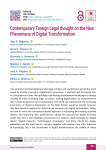Journal of Digital Technologies and Law @lawjournal-digital
Статьи журнала - Journal of Digital Technologies and Law
Все статьи: 220
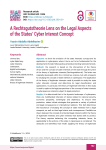
A Rechtsgutstheorie Lens on the Legal Aspects of the States’ Cyber Interest Concept
Статья
Objective: to show the evolution of the state interests concept and its application in cyberspace, where it turns out to be fundamental for the development of state military policy aimed at protecting national interests. Methods: the research is based on the intersection of the theory of law and the concept of cyber interests of the state through the prism of the theory of legitimate interests (Rechtsgutstheorie). The latter was originally developed within the criminal law science, but with prospects for studying the concept of state interests in cyberspace. The application of the theory of legitimate interests made it possible to study the state cyber interests concept and determine its legal classification and applications. In particular, the theory of legitimate interests in this study is used to explore the legal perspectives of the concept of state interests in cyberspace as interests subject to legal protection. Results: it is determined that in the dynamic landscape of cyberspace, there are multifaceted interests of states related to national security, economic prosperity, sovereignty and diplomacy. To ensure their protection, states initiate strategies that generate a variety of political and legal consequences in international relations. This fact determines the importance of studying the concept of state interests from a legal viewpoint, as well as their legal status and consequences. Parallels are drawn between the concept of protected legal interests within the theory of legitimate interests and cyber interests that states seek to protect. The theory requires balancing the competing interests; hence, its applicability to the actions of the state in cyberspace is considered. The obstacles are identified, that hinder applying the theory of legitimate interests to cyberspace, including difficulties of attribution, damage thresholds and the need for global consensus. The author shows the evolution of the concept of state interests, which determines the possibility of its application in cyberspace, where it serves the purposes of developing state policy aimed at protecting national interests. Scientific novelty: it is expressed in the reflection of the theory of legitimate interests to the formation of the legal concept of cyber interests of the state, which serves as a sufficient justification for the protection of specific cyber interests. Practical significance: the main conclusions outlined in the article can be used to identify cyberspace interests subject to legal protection (such as confidentiality, data integrity, sovereignty, and economic stability). They may also improve legal mechanisms for protecting national interests in cyberspace, ensure uniformity of relevant international judicial practice, and improve the efficiency and quality of state policy management in cyberspace in order to ensure security and peaceful coexistence.
Бесплатно
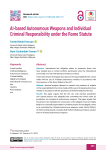
AI-based Autonomous Weapons and Individual Criminal Responsibility under the Rome Statute
Статья научная
Objective: international law obligates states to prosecute those who have violated laws in armed conflicts, particularly when the international community now has International Criminal Court (ICC). That is why the aim of the paper is to discover the responsibility for the crimes made with the use of AI-based autonomous vehicles in accordance with the provisions of the Rome Statute of the ICC. Methods: doctrinal analysis allowed to research the positions of experts on the responsibility for the crimes made with the use of AI-based autonomous vehicles in accordance with the provisions of the Rome Statute of the ICC. Results: this paper argues that the ICC can only exercise jurisdiction over natural persons who allegedly have committed the crimes under its jurisdiction, as compared to autonomous weapons. This paper argues that the persons who facilitate the commission of the alleged crimes are highly likely to be criminally responsible for providing means for the alleged crimes to be committed by AI-based autonomous weapons under Article 25(3)(c) of the Rome Statute and concludes that the Rome Statute provides a solution even to AI-based autonomous weapons. Scientific novelty: this paper addresses to the highly relevant issues of the responsibility for the crimes made with the use of AI-based autonomous vehicles in accordance with the provisions of the Rome Statute of the ICC. Practical significance: the results achieved in the paper can be used in regulation design for AI-based autonomous weapons. It can also be used as a basis for the future research in the sphere of liability of AI-based autonomous weapons and AI in general.
Бесплатно
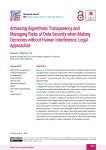
Статья
Objective: to compare modern approaches in law to the use of program codes and algorithms in decision-making that meet the principles of transparency and openness, as well as the increasingly stringent requirements for ensuring the security of personal and other big data obtained and processed algorithmically. Methods: the main methods for researching the principle of transparency in algorithmic decision-making were formal-legal and comparative analysis of legal acts and international standards of information security, as well as the principles and legal constructions contained in them. Results: it was determined that the development of information security standardization, inclusion in legal acts of requirements for the development of information technologies that comply with the principles of transparency and openness of applied algorithms will minimize the risks associated with the unlawful processing of users’ big data and obtaining information about their privacy. Proposals were identified, related to the implementation of algorithmic transparency in the field of data processing legal regulation. Recommendations were formulated, based on which the legislator can solve the problem of ensuring the openness of the logic of information technology algorithms with regard to modern standards of information security. Scientific novelty: it consists in the substantiation of new trends and relevant legal approaches, which allow revealing the logic of data processing by digital and information technologies, based on the characterization of European standards of the “privacy by design” concept in new digital and information technologies of decision-making and data protection, as well as on the new legal requirements for artificial intelligence systems, including the requirement to ensure algorithmic transparency, and criteria for personal data and users’ big data processing. This said, data protection is understood as a system of legal, technical and organizational principles aimed at ensuring personal data confidentiality. Practical significance: it is due to the need to study the best Russian and international practices in protecting the privacy of users of digital and information technologies, as well as the need for legislative provision of requirements for the use of algorithms that meet the principles of transparency and openness of personal data processing, taking into account the need to ensure confidentiality at all stages of the life cycle of their processing, which will ensure the continuity of security management.
Бесплатно
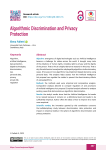
Algorithmic Discrimination and Privacy Protection
Статья научная
Objective: emergence of digital technologies such as Artificial intelligence became a challenge for states across the world. It brought many risks of the violations of human rights, including right to privacy and the dignity of the person. That is why it is highly relevant to research in this area. That is why this article aims to analyse the role played by algorithms in discriminatory cases. It focuses on how algorithms may implement biased decisions using personal data. This analysis helps assess how the Artificial Intelligence Act proposal can regulate the matter to prevent the discriminatory effects of using algorithms. Methods: the methods used were empirical and comparative analysis. Comparative analysis allowed to compare regulation of and provisions of Artificial Intelligence Act proposal. Empirical analysis allowed to analyse existing cases that demonstrate us algorithmic discrimination. Results: the study’s results show that the Artificial Intelligence Act needs to be revised because it remains on a definitional level and needs to be sufficiently empirical. Author offers the ideas of how to improve it to make more empirical. Scientific novelty: the innovation granted by this contribution concerns the multidisciplinary study between discrimination, data protection and impact on empirical reality in the sphere of algorithmic discrimination and privacy protection. Practical significance: the beneficial impact of the article is to focus on the fact that algorithms obey instructions that are given based on the data that feeds them. Lacking abductive capabilities, algorithms merely act as obedient executors of the orders. Results of the research can be used as a basis for further research in this area as well as in law-making process.
Бесплатно
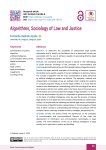
Algorithms, Sociology of Law and Justice
Статья
Objective: to determine the possibility of professional legal activity automation and to identify the limitations that in a democratic society are associated with the use of software capable of generating effective legal solutions in conflict situations. Methods: the conducted empirical research is based on the methodology of social sciences, sociology of law, principles of communicative and communicational theories of law, and formal-legal analysis of legal documents. Results: the paper presents examples of functioning of computer systems that imitate some specific aspects of human intelligence in decision-making. The concept of algorithm and the main characteristics of tasks performed by artificial intelligence systems are defined. The relevance, methods and achievements of sociology of law are outlined, which underlie the systems or computer programs helping to resolve legal conflicts. It is found that the research tools developed as a methodology within the sociology of law since its emergence will be more widely used in the future, due to the growing use of information and communication technologies in legal activities. It is shown that in the administration of justice it is impossible to generate solutions only on the basis of artificial intelligence, since law and the process of making legal decisions on its basis has more complex characteristics in a democratic society. It is emphasized that obtaining the desired legal result is not limited to the processes of algorithmization, categorization or formal exegetics of legal texts. It rather consists in understanding and thinking in accordance with the accepted values, meanings, evaluative criteria, strategies, perspectives, etc. Scientific novelty: the article reveals the significance of the principles of communicative and communicational theories of law under the development of information and communication technologies in legal activity. The main limitations of the use of artificial intelligence in legal activity and, in particular, in justice are identified. Practical significance: the formulated provisions help, while improving legal regulation, to avoid insufficiently justified decisions on the automation of law enforcement, as well as to take into account the increasing importance of the principles of communicative and communicational theories of law in such types of legal activities as creation, interpretation and application of laws.
Бесплатно
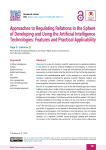
Статья научная
Objective: to review the modern scientific approaches to regulating relations in the sphere of using the artificial intelligence technologies; to reveal the main features and limitations of using the risk-oriented and technological approaches in order to determine the directions of their further development. Methods: the methodological basis of the research is a set of scientific cognition methods, including the general scientific dialectic method and the universal scientific methods (analysis and synthesis, comparison, summarization, structural-functional, and formal-logical methods). Results: it was determined that the use of the risk-oriented approach implies building constructive models of risk management. A significant issue in using this approach is the bases of referring the artificial intelligence technologies to high-risk ones. When determining the risk level of using the artificial intelligence technologies, the following criteria should be applied: the type of artificial intelligence technology, its sphere of use, and the level of potential harm for the environment, health and other fundamental human rights. In turn, the central issue of using the technological approach is the necessity and limits of regulation in the sphere of developing and using the artificial intelligence technologies. First, interference into this sphere must not create obstacles for developing technologies and innovations. Second, a natural reaction of a regulator towards newly emerging objects and subjects of turnover is the “imperfect law syndrome”. At the same time, a false idea about a lack of legal regulation may produce an opposite effect – duplication of legal norms. To solve the problem of duplicating legal requirements, it is necessary, first of all, to solve the issue of the need to regulate the artificial intelligence technologies or certain types of software applications. Scientific novelty: a review was carried out of the main approaches to regulating relations in the sphere of developing and using the artificial intelligence technologies; the opportunities and limitations of their use are revealed; further directions of their development are proposed. Practical significance: the main provisions and conclusions of the research can be used for determining the optimal approaches to regulating the sphere of digital technologies and for improving the legal regulation of the studied sphere of social relations.
Бесплатно
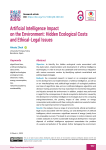
Artificial Intelligence Impact on the Environment: Hidden Ecological Costs and Ethical-Legal Issues
Статья
Objective: to identify the hidden ecological costs associated with the elaboration, implementation and development of artificial intelligence technologies, in order to ensure its sustainable and harmonious integration with various economic sectors by identifying optimal moral-ethical and political-legal strategies. Methods: the conducted research is based on an ecological approach to the development and implementation of artificial intelligence, as well as on an interdisciplinary and political-legal analysis of ecological problems and risks of algorithmic bias, errors in artificial intelligence algorithms and decision-making processes that may exacerbate environmental inequalities and injustice towards the environment. In addition, analysis was performed in regard to the consequences of natural ecosystems destruction caused by the development of artificial intelligence technologies due to the computing energy-intensiveness, the growing impact of data centers on energy consumption and problems with their cooling, the electronic waste formation due to the rapid improvement of equipment, etc. Results: the analysis shows a range of environmental, ethical and political-legal issues associated with the training, use and development of artificial intelligence, which consumes a significant amount of energy (mainly from non-renewable sources). This leads to an increase in carbon emissions and creates obstacles to further sustainable ecological development. Improper disposal of artificial intelligence equipment exacerbates the problem of e-waste and pollution of the planet, further damaging the environment. Errors in artificial intelligence algorithms and decision-making processes lead to environmental injustice and inequality. AI technologies may disrupt natural ecosystems, jeopardizing wildlife habitats and migration patterns. Scientific novelty: the environmental consequences of the artificial intelligence use and further development, as well as the resulting environmental violations and costs of sustainable development, were studied. This leads to the scientific search for optimal strategies to minimize environmental damage, in which legal scholars and lawyers will have to determine ethical-legal and political-legal solutions at the national and supranational levels. Practical significance: understanding the environmental impact of AI is crucial for policy makers, lawyers, researchers, and industry experts in developing strategies to minimize environmental harm. The findings emphasize the importance of implementing energy efficient algorithms, switching to renewable energy sources, adopting responsible e-waste management practices, ensuring fairness in AI decision-making and taking into account ethical considerations and rules of its implementation.
Бесплатно
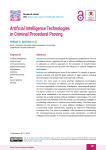
Artificial Intelligence Technologies in Criminal Procedural Proving
Статья научная
Objective: to summarize and analyze the approaches, established in criminal procedural science, regarding the use of artificial intelligence technologies, to elaborate an author’s approach to the prospects of transformation of criminal procedural proving under the influence of artificial intelligence technologies. Methods: the methodological basis of the research is integrity of general, general scientific and specific legal methods of legal science, including abstract-logical, comparative-legal and prognostic methods. Results: the main areas of using artificial intelligence technologies in the criminal procedure are defined, such as prophylaxis and detection of crimes, organization of preliminary investigation, criminological support of crime investigation, and assessing evidences at pre-trial and trial stages. The author comes to a conclusion that the rather optimistic approach to this issue, established in the science of criminal procedure, significantly outstrips the actually existing artificial intelligence technologies. The main requirements are identified, which the activity of using artificial intelligence in collecting evidences in a criminal case should satisfy. The author pays attention to the problems of using artificial intelligence technologies in conducting expert assessments, requiring an improved methodology of forensic work. The issue is considered of the prospects of transforming the criminal-procedural proving process under introduction of artificial intelligence technologies. A conclusion is substantiated that the assessment of evidences with mathematical algorithms, in which preset values of each evidence quality are used, contradict to the principle of free assessment of evidences in the criminal procedure. The author comes to a conclusion that today there are no sufficient grounds for endowing artificial intelligence with legal personality during proving. Scientific novelty: the work presents an attempt to consider the role of artificial intelligence in the criminal-procedural proving; it specifies the requirements to be met by this technology during evidences collection and analyzes the prospects of transforming the proving process under the introduction of artificial intelligence technologies. Practical significance: the main provisions and conclusions of the research can be used to improve a mechanism of legal regulation of artificial intelligence technologies in the criminal procedure.
Бесплатно
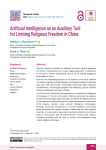
Artificial Intelligence as an Auxiliary Tool for Limiting Religious Freedom in China
Статья научная
Objective: based on studying the statistics of crimes, national legislation and norms of international law, to give a legal assessment to restrictions of the right to worship implemented with the use of artificial intelligence technologies in China. Methods: the methodological basis of the research is the set of methods of scientific cognition, including specific sociological (analysis of statistical data and other documents), formal-legal (examining legal categories and definitions), formal-logical (analysis and synthesis), general scientific (induction, deduction), and other methods. Results: the work researches prerequisites for using artificial intelligence technologies in China to control public relations arising during religious activity both in the digital space and beyond; analyzes the legal framework of the measures implemented; gives a legal assessment to restrictions of the religious freedom using artificial intelligence technologies; forecasts the further development of Chinese legislation and foreign policy associated with religious freedom. Additionally, the work analyzes materials of human rights organizations aimed at hindering the Chinese policy of “sinicisation” and “de-extremification” of ethnic and religious minorities, including with the help of control and propaganda using modern digital technologies. Scientific novelty: the work researches the attempt of China to regulate the challenges related to religious activity, arising during rapid digitalization of the society and state, which the Republic faces being a developing, multinational and polyconfessional country. The established restrictions of religious freedom using artificial intelligence technologies are considered along with the relevant criminal statistics. The legal assessment of using artificial intelligence as a tool for restricting the right to worship is given from the standpoint of international law, as well as with the account of Chinese national legislation. Practical significance: the research results can be used to elaborate a consistent legal framework for using artificial intelligence technologies to counteract extremism.
Бесплатно
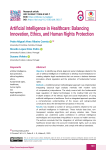
Artificial Intelligence in Healthcare: Balancing Innovation, Ethics, and Human Rights Protection
Статья
Objective: to identify key ethical, legal and social challenges related to the use of artificial intelligence in healthcare; to develop recommendations for creating adaptive legal mechanisms that can ensure a balance between innovation, ethical regulation and the protection of fundamental human rights. Methods: a multidimensional methodological approach was implemented, integrating classical legal analysis methods with modern tools of comparative jurisprudence. The study covers both the fundamental legal regulation of digital technologies in the medical field and the in-depth analysis of the ethical, legal and social implications of using artificial intelligence in healthcare. Such an integrated approach provides a comprehensive understanding of the issues and well-grounded conclusions about the development prospects in this area. Results: has revealed a number of serious problems related to the use of artificial intelligence in healthcare. These include data bias, non-transparent complex algorithms, and privacy violation risks. These problems can undermine public confidence in artificial intelligence technologies and exacerbate inequalities in access to health services. The authors conclude that the integration of artificial intelligence into healthcare should take into account fundamental rights, such as data protection and non-discrimination, and comply with ethical standards. Scientific novelty: the work proposes effective mechanisms to reduce risks and maximize the potential of artificial intelligence under crises. Special attention is paid to regulatory measures, such as the impact assessment provided for by the Artificial Intelligence Act. These measures play a key role in identifying and minimizing the risks associated with high-risk artificial intelligence systems, ensuring compliance with ethical standards and protection of fundamental rights. Practical significance: adaptive legal mechanisms were developed, that support democratic norms and respond promptly to emerging challenges in public healthcare. The proposed mechanisms allow achieving a balance between using artificial intelligence for crisis management and human rights. This helps to build confidence in artificial intelligence systems and their sustained positive impact on public healthcare.
Бесплатно
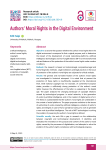
Authors’ Moral Rights in the Digital Environment
Статья
Objective: to answer the question whether the authors’ moral rights the in the digital environment correspond to their original purpose, and to determine the impact of the development of social networking platforms, artificial intelligence technologies and non-fungible tokens (NFT) on the transformed role and features of the protection of the author’s moral rights under modern conditions. Methods: the research is based on historical-legal, comparative-legal and formal-dogmatic methods. Legal institutions and legal practice on the issue of protection of the author’s moral rights are subjected to critical analysis. Results: the genesis and normative fixation of the author’s moral rights are investigated in historical retrospect. It is noted that at present the protection of these rights is insufficiently regulated at the international level, while national copyright law, for example, of continental European states, provides a sufficiently strong protection of the author’s moral rights; however, the effectiveness of the latter is weakening in the digital age. The paper analyzes the changing landscape of copyright relations caused by technological progress: in social networks, in the generation of works by artificial intelligence, and in the creation of digital works of art. The thesis is substantiated that the author’s moral rights are undesirable in the context of social platforms. The paper proposes solutions to the issues of authorship of works created by artificial intelligence, violation of author’s rights, and integrity in case of full or partial borrowing of a work to generate a new work by artificial intelligence. The role of NFT technologies in solving the problem of preserving the author’s moral rights is defined. Scientific novelty: the work fills a gap in research on the relationship between copyright and technological development. It identifies and evaluates the innovations in the purpose and content of the author’s moral rights, caused by the processes of digitalization, and attempts to solve the problem of the author’s rights compliance with technological progress. Practical significance: the obtained results may serve as a conceptual basis for further development and improvement of national legislation and international legal regulation in the field of copyright protection, transformation of the objectives, role and place of the author’s moral rights in the digital environment.
Бесплатно
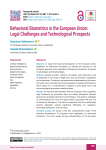
Behavioral Biometrics in the European Union: Legal Challenges and Technological Prospects
Статья
Objective: to study the historical development of the European Union legislation on behavioral biometrics; to identify the features of the European approach to the regulation of behavioral biometrics, to assess its advantages and disadvantages. Methods: general scientific methods of analysis and comparison, with an emphasis on the study of legal texts such as directives, regulations and conventions. To ensure a comprehensive understanding of the issue, the authors also consider the technical aspects of behavioral biometrics, which allows for a comprehensive analysis of both legal norms and the technological processes underlying them. Results: the research demonstrates that the European Union regulatory legal framework on biometrics does not clearly distinguish between behavioral and physical biometrics technologies. This leads to ambiguity in understanding the risks and opportunities associated with the use of behavioral biometrics. The authors emphasize that the insufficiently specific legislation creates significant difficulties for regulators, technology developers, and end users. Scientific novelty: the article is the first comprehensive study of the historical development of European Union legislation on behavioral biometrics. The work reveals the key characteristics of the European approach, its strengths and weaknesses, and compares it with the United States’ regulatory practice. The study reveals the key aspects that require further regulation: from a clear definition of behavioral biometrics to the development of comprehensive mechanisms to ensure transparency and accountability in the use of these technologies. Given that behavioral biometrics is a relatively new and rapidly developing technology, the research is important for understanding current challenges and prospects for its regulation. Practical significance: the research is multifaceted and relevant for experts in digital technologies: legal scholars, law enforcement officers, legislators, and developers of artificial intelligence and biometrics technologies.
Бесплатно
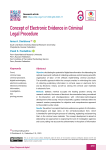
Concept of Electronic Evidence in Criminal Legal Procedure
Статья научная
Objective: elucidating the potential of digital transformation for elaborating the optimal means and methods of collecting evidences and introducing scientific organization of labor of the officials implementing criminal procedure. The scientific approach within the concept consists in minimizing the costs of collecting evidentiary information in criminal cases in electronic form and by electronic means, as well as storing the criminal case materials in electronic form. Methods: dialectic method occupies the leading position among the research methods, the issues of electronic documentation being considered in the interaction and interdependence with information-technological development of the society. The set of scientific cognition methods within the research creates prerequisites for objective and comprehensive approach to the problems under study. Results: the authors’ concept of electronic evidence is a system of information-technological and legal views on the criminal-procedural form, which is intended for optimizing the process of collecting, registering and preserving them in the criminal case materials. The concept development is aimed at elaborating new approaches to organizing the work of investigation agencies and courts, taking into account the achievements in the sphere of information technologies, providing new techniques of collecting criminal-relevant, criminal-procedural, criminological significant information when investigating and hearing of a criminal case. The proposed concept is also aimed at improving interaction and in-service communication of the officials of the preliminary investigation bodies with the officials of information-technological systems for the purposes of collecting evidentiary information in electronic form. Scientific novelty: the changes were systemically analyzed, which are taking place in the contemporary information society, through the prism of the emerging problems between the sectoral criminal-procedural evidentiary law and more modern technological means of collecting evidentiary information. The article demonstrates a new approach to creating technological interaction using digital technologies, on the scientific base of organization of proving activity, intended to optimize and rationalize the process of proving in criminal procedure. Practical significance: the research materials can be used to prepare proposals on making changes and additions in the current legislation with a view of implementing the practice of already functioning models of criminal-procedural activity of foreign countries, an inexhaustible potential of information-technologies, software, and artificial intelligence to rationalize proving in criminal cases.
Бесплатно
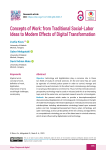
Concepts of Work: from Traditional Social-Labor Ideas to Modern Effects of Digital Transformation
Статья научная
Objective: technology and digitalization play a converse role in these two fields of study of criminal sciences. On the one hand, they are used by agencies of criminal justice system in order to control, manage and prevent crime and criminals. On the other hand, criminals enjoy technology in carrying out their plans to commit crime. Thus, from the criminal sciences’ perspective, technology may be used or misused, and this is an interesting topic, and at the same time, an important research area for criminologists. Methods: the present article seeks to provide a descriptive-analytical discussion about digitalization of criminology and criminal justice in the light of modern technologies, internet and cyberspace. It introduces new areas and sub-disciplines including administrative criminology based upon actuarial justice and risk management/assessment theory, cyber criminology and cyber victimology, as two sub-disciplines of the new century, and algorithmic or computational criminology, as one of the latest area in criminal sciences, which all are influenced by digitalization and technology. Results: authors concluded that due to the digitalization atypical work emerges but legislator defines the scope of work regulated by law and that makes atypical work relationship becomes a typical work relationship. At the same time some areas fall into the gray zone. To fix that legislator should provide an interpretation that will not become empty in a year or two due to technological changes. Scientific novelty: the applicability of technology and digitalization in criminology and criminal justice has widely increased and developed, specifically since the beginning of the third millennium. Practical significance: digitalization and Technology has become increasingly important to criminology and criminal justice at both the theory and practice within the sphere of social and criminal sciences. The nature and types of crime and criminals, and also the methods and mechanisms of control and preventing them in the light of requirements of criminal policy and criminal justice are highly dependent upon technology and digitalization.
Бесплатно

Статья
Objective: to identify the prospects of international trade in the light of synchronizing Incoterms with smart contracts. Methods: the study is based on the general scientific methods of analysis, synthesis, comparison, and formal-legal method necessary to analyze the provisions of Incoterms. Results: the authors analyzed the provisions of Incoterms and technological innovations in commercial law; showed the connection between the practice of commercial law and technological development due to the inclusion of contractual terms in blockchain. It is noted that the integration of blockchain technology with smart contracts has led to a variety of automated business transactions and the creation of a platform for synthetic assets trading. The authors describe the possibilities of secure and easy transactions in international trade using blockchain. Despite the uniqueness of this technology, its different types are distinguished, namely: public, private, hybrid, and consortium blockchain. It is substantiated that the synchronization of Incoterms with smart contracts can improve the prospects of international trade (especially export-import contracts). It is emphasized that smart contracts based on blockchain can revolutionize the application of Incoterms, consequently increasing the efficiency of transactions between parties to export-import relationships. One of the fundamental changes that smart contracts will bring to these trade transactions is the reduction of errors and misinterpretations of Incoterms. The authors use specific cases to demonstrate disputes arising at the stages of transaction conclusion and execution, which could have been avoided using modern technologies. Scientific novelty: The paper shows the phenomenon of synchronizing Incoterms with blockchain and how it can affect the form of contracts and facilitate their smooth execution. The proposed approach to analyzing the phenomenon takes into account the revolutionary innovations in cross-border trade, which are compared with the usual ways of applying Incoterms in traditional international trade contracts. Practical significance: the research provides suggestions and recommendations for further development of innovations in the field of smart contracts, especially export-import trade contracts on a global scale.
Бесплатно
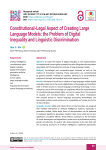
Статья
Objective: to study the impact of digital inequality on the implementation of constitutional human rights; to identify the risks of linguistic discrimination associated with the development and use of large language models. Methods: formal-legal and comparative-legal methods, as well as the method of theoretical modeling. These approaches are complemented by general scientific methods of cognition, allowing for a comprehensive analysis of the legal, technological and social aspects of the issue. Results: the research found that, in relation to large language models, digital inequality arises due to the uneven digitalization of languages and manifests itself in limited access to natural language processing technology. In turn, unequal access to this technology can negatively affect the implementation of constitutionally guaranteed rights and can be viewed from the viewpoint of equality and non-discrimination concepts. The author emphasizes that unequal access to natural language processing technologies can exacerbate existing social and economic inequalities and create new forms of discrimination. Scientific novelty: hidden and indirect forms of discrimination are analyzed that manifest themselves in artificial intelligence systems, especially in generative models. While direct forms of discrimination can be detected in predictive algorithms, generative models create more subtle but no less significant cumulative effects. These effects contribute to the formation of social stereotypes and inequalities in areas such as professional activity, gender and ethnicity. The author also draws attention to the fact that with the increasing autonomy of artificial intelligence, traditional approaches to discrimination detection are becoming less effective, which requires the development of new analysis and regulation methods. Practical significance: the results provide a basis for identifying and assessing the legal risks associated with unequal access to digital products using natural language processing. This contributes to the improvement of legal regulation in the field of the development and use of artificial intelligence technologies. The article offers recommendations for lawmakers, regulators, and technology developers aimed at minimizing the risks of digital inequality and linguistic discrimination.
Бесплатно
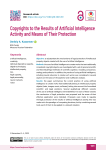
Copyrights to the Results of Artificial Intelligence Activity and Means of Their Protection
Статья
Objective: to substantiate the mechanisms of legal protection of intellectual property objects created with the use of artificial intelligence. Methods: the use of artificial intelligence to create works that are traditionally considered copyright objects was investigated with a set of general scientific and theoretical-legal methods of scientific cognition, including comparison, analogy and synthesis. In addition, the practice of using artificial intelligence, including neural networks, to create such works was considered in several aspects on the basis of retrospective and multifactor analysis. Results: the paper summarizes the current practice of using artificial intelligence to create works that traditionally belong to intellectual property objects (texts, images, music, software), taking into account the formulated scientific and legal positions. Several qualitatively different variants of the use of artificial intelligence were identified. For each of these variants the mechanism of legal protection was proposed and the areas of their effective application were indicated. Proposals were made to regulate the legal protection of the results of artificial intelligence activity; this was made not in the paradigm of competing doctrines, but by combining several tools, each of them to be applied in a relevant situation. Scientific novelty: the paper presents ontological differentiation of the results of artificial intelligence activity and the corresponding mechanisms of their legal protection. The author propose to consider the results of activity created by artificial intelligence not as a single object of legal regulation, but as a set of externally similar, but ontologically different objects, each requiring a separate approach to legal protection. Practical significance: the ontological differentiation of the results of artificial intelligence activity and their corresponding legal protection mechanisms proposed in this paper is relevant both as a basis for further research and as proposals to supplement civil legislation.
Бесплатно
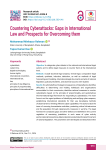
Countering Cyberattacks: Gaps in International Law and Prospects for Overcoming them
Статья
Objective: to categorize cyber attacks in the national and international legal sytems and to define legal measures to counter them at the international level. Methods: include doctrinal legal analysis, formal legal, comparative legal methods, synthesis, induction, deduction, as well as methods of legal forecasting and modeling. International legal documents and acts of national legislation, judicial precedents, and doctrinal sources were studied. Results: the article defines the legal consequences of cyberattacks, identifies difficulties in determining and holding individuals and organizations accountable for their commission, identifies national measures to counter cyberattacks based on the principle of proportionality, and systematizes the international legal framework for responding to cyberattacks. The main focus is on the urgent problems of identifying and verifying cyber weapons, establishing international standards for their use, developing methods of disarmament or limiting offensive cyber capabilities. The authors raise the issue of ensuring humanitarian activities, protecting critical infrastructure and the population through cybersecurity measures in wartime. The legal framework is analyzed; gaps and other defects are identified in the current regulation of exercising jurisdiction in such areas of cyber activity as international transactions, data localization and extraterritorial enforcement of national legislation. The parameters were developed and described within which states may conduct proactive cyber operations to prevent or deter cyberattacks (cyber countermeasures). The main parameters are due diligence, legal decisions on using cyber countermeasures, proportionality of protection measures to the consequences of illegal actions. Scientific novelty: this is due to the progressive solutions in the field of international legal regulation of cyber countermeasures by states responding to cybercrime. The solutions are formulated taking into account the impact of the countermeasures on human and civil rights and freedoms, including the right to privacy and freedom of speech. Practical significance: the research results can be used to develop and improve international legal instruments in the field of combating cyberattacks and ensuring cybersecurity, and can serve as a model for national legislators when designing law-making solutions to counter cybercrime.
Бесплатно
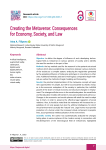
Creating the metaverse: consequences for economy, society, and law
Статья научная
Objective: to define the degree of influence of such developing technological field as metaverse on various spheres of society and to identify the need for reaction on the part of law. Methods: the key method used for the research is the systemic-structural method, which allows establishing connections between various elements of the society as a complex system, analyzing the regularities generated by the spreading influence of metaverse prototypes in one sphere on other ones. Additional methods used are formal-logical, comparative-legal methods, as well as the methods of legal modeling and forecasting. Results: the practical implementation of the metaverse concept will open new opportunities for people, but will be accompanied by drastic changes in the economic subsystem of the society, in particular, the multifold growth of the share of virtual economy and structural changes in employment. The changes will also occur in the social subsystem: the social links and the education models will transform, new personal demands will occur. Changes in the economic and social spheres will entail the need to adapt law to them, in order to preserve the effective legal regulation of social relations. Also, it should be noted that the metaverse will increase the capabilities of not only people but also the artificial intelligence, for which virtual environment is actually the “natural” one. Legal norms must provide protection of a human under the increased virtual component in people’s lives, accompanied by intellectualization of the environment. Scientific novelty: the author has systematically analyzed the changes taking place in various spheres of the modern society in connection with the development of the technological field of metaverses; highlighted the key issues arising due to the said development and requiring legal solution both at the constitutional level and at the level of sector legislation; and proposed the necessary changes in legal regulation. Practical significance: the research materials can be used when preparing proposals on changes and amendments in the current legislation, as well as in pedagogical activity, in particular, for implementation of educational courses or modules related to law under digital transformation of the society.
Бесплатно

